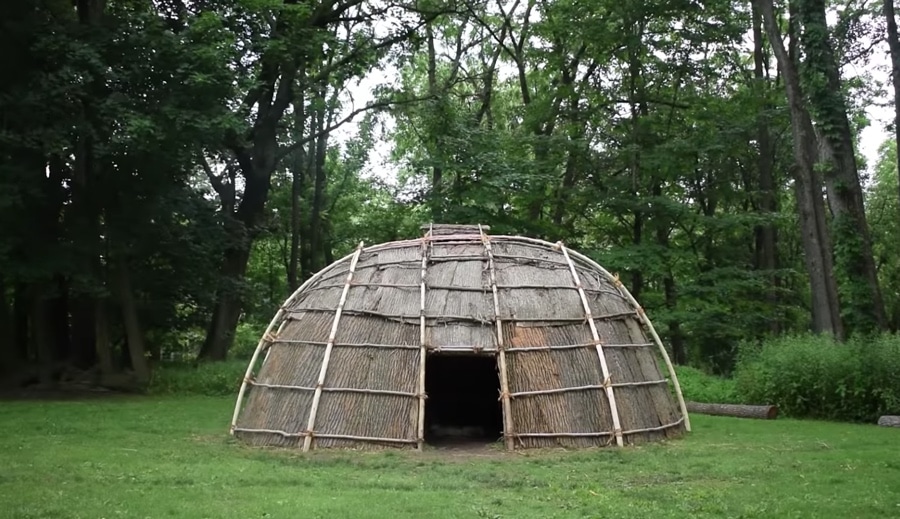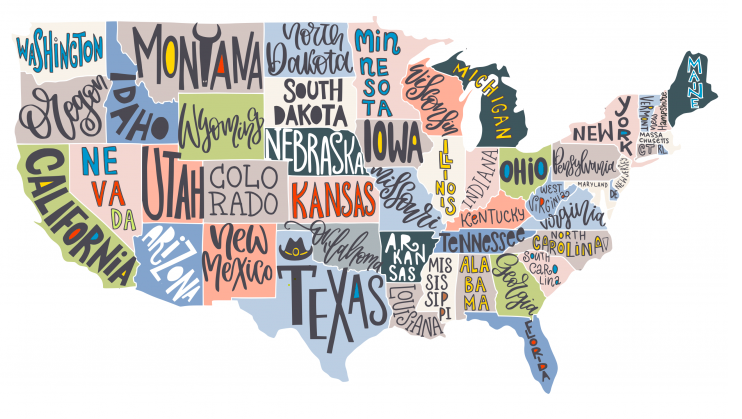Village of Pomeioc, North Carolina

 How many different historic First American/American Indian dwellings do you know?
How many different historic First American/American Indian dwellings do you know?
- At tables ask students individually to draw a first Native American or American Indian dwelling that they learned about in school and do not share their drawing with other people at their table.
- Once everyone is finished, then students at each table will share their drawings and total up the different types of structures that were drawn.
- In a recent college class, 64% of the undergraduate students drew teepees even though only nomadic tribes of Plains Indians lived in these structures.
Pictures and a short description
 LEARNING PLAN: Native American Dwellings from the U.S. Census Bureau.
LEARNING PLAN: Native American Dwellings from the U.S. Census Bureau.
- Highlights teepees, pueblo adobe structures, and hogans
Choose a dwelling to build and learn about:
Adobe Houses
Earthen Houses
Plank Houses
Brush Shelters
Wigwams
Longhouses
Grass Houses
Wattle and Daub Houses
Chickees
Igloos
Wigwams
Apache wigwam near Fort Thomas, Arizona, 1927


- Wigwams are round, domed huts that were used by many different Native American cultures. Tribes in the Northeastern United States usually called these structures wigwams, while tribes in the Southwestern United States often called them wickiups.
- Click here for more information.
 Go here for a time lapse video of a Wigwam being built. 2x speed
Go here for a time lapse video of a Wigwam being built. 2x speed

Longhouses
Mohawk Iroquois Longhouse, New York State Museum
 Building of the Iroquois Long House 2x speed
Building of the Iroquois Long House 2x speed
Tepees
 How to Build a Teepee 1.5 speed
How to Build a Teepee 1.5 speed
Grass houses
 We Helped Build a Caddo Grass House 1.5 speed
We Helped Build a Caddo Grass House 1.5 speed
Grass House Construction
Wattle and Daub homes
 Wattle and Daub Houses: How Native Americans Built Their Homes 2x speed
Wattle and Daub Houses: How Native Americans Built Their Homes 2x speed
Wattle and Daub Weave and Mud Structures show 3:00 - 6:00 2x speed
https://ny.pbslearningmedia.org/resource/wattle-and-daub-houses-indian-mounds-video/virtual-field-trips/

Chickees
 Chickees from WGCU Public Media 2x speed
Chickees from WGCU Public Media 2x speed
Chickees
 Seminole History
Seminole History
- The Seminoles of Florida call themselves the "Unconquered People," descendants of just 300 Indians who managed to elude capture by the U.S. army in the 19th century after the passage of the Indian Removal Act.
- The Seminole Tribe is the only tribe in America who never signed a peace treaty with the United States (Tribal website)
Pueblo de Taos World Heritage Site

Adobe houses (Pueblo homes)
 Pueblo Homes 1:30 - 5:15 1.5 speed
Pueblo Homes 1:30 - 5:15 1.5 speed
- Some pueblos were very large with more than 100 rooms! The rooms were built in long rows and could house many families. Most pueblos had large underground rooms called kivas that were used for ceremonies and meetings.
- The largest adobe building in the world, and probably the most famous adobe structure standing, is the Great Mosque of Djenné in central Mali, near the edge of the Sahara Desert.
Earthen homes


.png) Building an EarthLodge 0:00- 3:10 1.5 speed
Building an EarthLodge 0:00- 3:10 1.5 speed
Earth Lodges, Encyclopedia of the Great Plains, University of Nebraska
Earthlodge, Knife River Indian Villages, North Dakota
 What was the impact of horses on Native people and cultures?
What was the impact of horses on Native people and cultures?
Wild Horse Migration Interactive Map
Plank houses
Plank Houses of the Pacific Northwest
.png) Building a Native American Plank House 1.5 speed
Building a Native American Plank House 1.5 speed
Native Peoples of the Northwest Plank houses start at 6:30 8:30 1.5 speed
Igloos
.png) How to Build an Igloo: A Boy Among Polar Bears 0:00 -2:50 at 1.0 speed
How to Build an Igloo: A Boy Among Polar Bears 0:00 -2:50 at 1.0 speed

A Boy Among Polar Bears information (same video as above).
How to Make an Igloo, New York Times (must sign in to the NY Times first)
Brush Shelters
.png) Building a Winter Brush Shelter 2x speed (NOT MUCH TALKING)
Building a Winter Brush Shelter 2x speed (NOT MUCH TALKING)
Learning about Biomes and Habitats
 Interactive map where you can explore how and when portions of the United States were ceded from Native Americans and which tribes they were taken from.
Interactive map where you can explore how and when portions of the United States were ceded from Native Americans and which tribes they were taken from.

What is a Biome?
- A biome is a large area characterized by its vegetation, soil, climate, and wildlife.
The World's Biomes (University of California Museum of Paleontology)
Pictures of the world's 6 biomes
fresh water
marine (sea)
forest
desert
grassland
tundra
"The main components of a habitat are shelter, water, food, and space. A habitat is said to have a suitable arrangement when it has the correct amount of all of these. Sometimes, a habitat can meet some components of a suitable arrangement, but not all." -National Geographic Resource Library
Jamboard by Lauren Morneweck, December 2020

As part of this makerspace activity, create a canva or a google slide to answer these questions:
Put a photo into the Canva or google slide of the dwelling you make.
Hands-On Materials to Use for Your Makerspace
|
Empty Cardboard Cereal Boxes
Small, Large and Craft Scissors
Corks
Glue Sticks and Glue Guns
Empty Plastic Containers
Legos
Goldie Bloxs
K’Nex
Rubber Bands
Posterboard
Paint Swatches
Paper Bags
Rectangles, Squares, Ovals and Circles of Magazine Pages Cut Into Shapes
|
Pre-Cut Cardboard Pieces
Playdoh
Different Lengths of String
Scotch Tape and Multi-colored Duct Tape
Popsicle Sticks and Toothpicks
Cubelets
Keva Structures
Copper Foil Tape
Pipe Cleaners
Magnets
Cotton Balls
Buttons
Packaging from Cookies, Muffins, Plastic That is in Fractioned Compartments
|
 Stunning Footprints Push Back Human Arrival in Americas by Thousands of Years
Stunning Footprints Push Back Human Arrival in Americas by Thousands of Years

- Biggest Discovery in 100 years (reported in 2021).
- Puts human beings in the area of the White Sands National Monument in New Mexico some 21,000 to 23,00 years ago
- Early views put first humans in North America 13,000 years ago in Clovis, New Mexico as part of the Land Bridge theory between Asia and North America
- Researchers in the 1970s proposed first humans arrived 16,000 to 17,000 years ago by water as they moved down the Pacific Coast
 CROSS-LINK: Peopling of the Americas
CROSS-LINK: Peopling of the Americas
Comments (0)
You don't have permission to comment on this page.